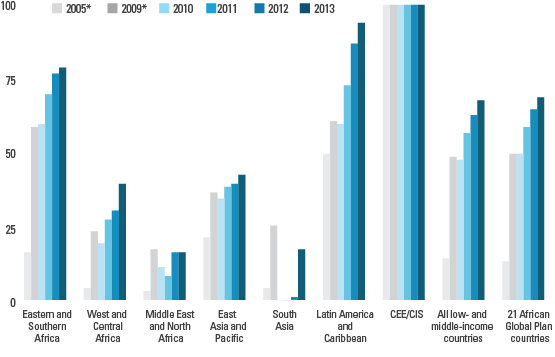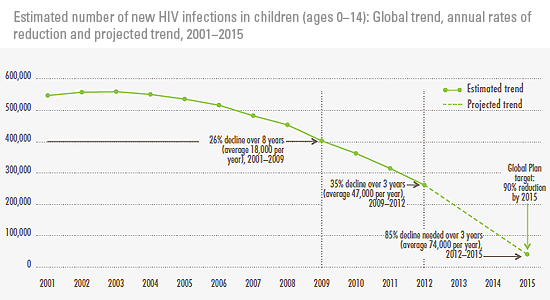About 90 per cent of HIV infections in infants and children were passed on by their mothers during pregnancy, delivery or breastfeeding. Transmission of the virus from mother to child can be significantly reduced if antiretroviral drugs are administered to a woman during pregnancy and delivery and to her baby shortly after birth. Without any intervention, between 15 per cent and 45 per cent of babies born to HIV-positive mothers will become infected. And half of all infants infected with HIV will die before their second birthday if they do not receive treatment.
In 2011, the UN Secretary-General launched a new Global Plan to reduce HIV infections in children by 90 per cent by 2015 and to increase survival rates of pregnant women and new mothers who are HIV-positive. While service uptake is increasing, and new HIV infections among children are declining rapidly, progress must accelerate to meet the 2015 deadline.
PREVALENCE OF PREGNANT WOMEN WHO ARE HIV-POSITIVE
In 2013, an estimated 1.5 million pregnant women were living with HIV globally. Over 90 per cent of these women are concentrated in sub-Saharan African countries.
Reducing HIV transmission from mother to child requires a range of interventions, beginning with voluntary and confidential counselling and testing for the virus. This should be followed by lifelong antiretroviral treatment for pregnant women with HIV and the administration of antiretroviral drugs to their newborns as a preventive measure. Safe delivery practices must also be followed, and new mothers should receive guidance in selecting a suitable infant-feeding option.
A GLOBAL PLAN
In June 2010, under the leadership of UNICEF, UNAIDS and WHO, United Nations organizations and key global partners committed to work together to eliminate HIV in newborns and children. One year later, at the UN General Assembly High-level Meeting on AIDS, the United Nations Secretary-General launched a Global Plan to reduce new HIV infections among children by 90 per cent by 2015. By the same date, the plan seeks to reduce HIV-related deaths among pregnant women and new mothers (until six weeks after delivery) by 50 per cent. The plan outlines specific, time-bound targets at the global level, which have been adapted by countries to support this goal. It also identifies 22 priority countries that are receiving intensified support.[1]
[1] Angola, Botswana, Burundi, Cameroon, Chad, Côte d’Ivoire, Democratic Republic of the Congo, Ethiopia, Ghana, India, Kenya, Lesotho, Malawi, Mozambique, Namibia, Nigeria, South Africa, Swaziland, Uganda, United Republic of Tanzania, Zambia and Zimbabwe.
PROGRESS
Expanding HIV testing and counselling among pregnant women is critical for identifying those in need of follow-up care and increasing coverage of subsequent interventions. This is especially important since too few women expecting a child are aware of their HIV status. In 2013, an estimated 44 per cent of pregnant women in low- and middle-income countries received an HIV test, up from 26 per cent in 2009 and 8 per cent in 2005.
Many countries are also making progress in providing antiretroviral medicines to pregnant women living with HIV. In 2013, 67 per cent of pregnant women living with HIV in low- and middle-income countries were on an effective antiretroviral drug regimen, an increase from 47 per cent in 2010.
Among UNICEF regions, Central and Eastern Europe and the Commonwealth of Independent States (CEE/CIS) has the highest coverage ( greater than 95 per cent) of antiretroviral medicines among pregnant women who are HIV-positive. This is followed by Latin America and the Caribbean (93 per cent) and Eastern and Southern Africa (78 per cent). All other regions have coverage of under 50 per cent: East Asia and the Pacific (42 per cent), West and Central Africa (39 per cent), South Asia (17 per cent) and Middle East and North Africa (16 per cent).
Dramatic declines have been observed in the number of infants newly infected with HIV, and progress is accelerating, largely because of increased access to related services. Still, faster progress is needed to reach the 2015 Global Plan target of a 90 per cent reduction in new HIV infections in children between 2009 and 2015.
World Health Organization (WHO) guidelines recommend that all infants born to HIV-positive mothers should receive antiretroviral drugs preventively. Coverage of antiretroviral prophylaxis among infants was still lower than coverage among mothers in 2013. However, an estimated 51 per cent of the estimated 1.5 million infants born to mothers living with HIV received prophylactic drugs.
Data show that the use of services related to the prevention of mother-to-child transmission of HIV is expanding. Still, formidable challenges must be overcome before Global Plan targets can be met. Poor service delivery in hard-to-reach areas, aggravated by weak health systems, and the fear, stigma and denial that discourage women from being tested for HIV are significant barriers to wider uptake of services.
For more data and analysis on HIV and AIDS in children, see UNICEF’s Children and AIDS: Sixth stocktaking report by clicking here.
REFERENCES
UNAIDS, Report on the Global AIDS Epidemic, UNAIDS, Geneva, 2013.
UNAIDS, Global AIDS Response Progress Reporting 2014. Guidelines: Construction of core indicators for monitoring the 2011 Political Declaration on HIV/AIDS, UNAIDS, Geneva, 2014.
UNICEF, Children and AIDS: Sixth stocktaking report, UNICEF, New York, 2013.
UNICEF, Progress for Children: A report card on adolescents, No. 10, UNICEF New York, 2012.
UNICEF, Progress for Children: Achieving the MDGs with equity, No. 9, UNICEF New York, 2010.
UNICEF, The State of the World’s Children 2014 in Numbers: Every child counts – Revealing disparities, advancing children’s rights, UNICEF, New York, 2014.
UNICEF, The State of the World’s Children 2013: Children with disabilities, UNICEF, New York, 2013.
UNICEF, UNAIDS, UNESCO, UNFPA, ILO, WHO and The World Bank, Opportunity in Crisis: Preventing HIV from early adolescence to young adulthood, UNICEF, New York, 2011.
WHO, Global Update on HIV Treatment 2013: Results, impact and opportunities, WHO, Geneva, 2013.
WHO, UNAIDS and UNICEF, Global HIV/AIDS Response: Epidemic update and health sector progress towards universal access – Progress report 2011, UNAIDS, Geneva, 2011.
[1] Angola, Botswana, Burundi, Cameroon, Chad, Côte d’Ivoire, Democratic Republic of the Congo, Ethiopia, Ghana, India, Kenya, Lesotho, Malawi, Mozambique, Namibia, Nigeria, South Africa, Swaziland, Uganda, United Republic of Tanzania, Zambia and Zimbabwe.





